RDNA 2 has been rumored, it's been speculated on, heck, I even played on the new architecture in the Xbox, but now we finally got the details for the PC add-in cards, and the first thing we know is that AMD is using the same seven-nanometer process as their previous Radeon 5000 series cards.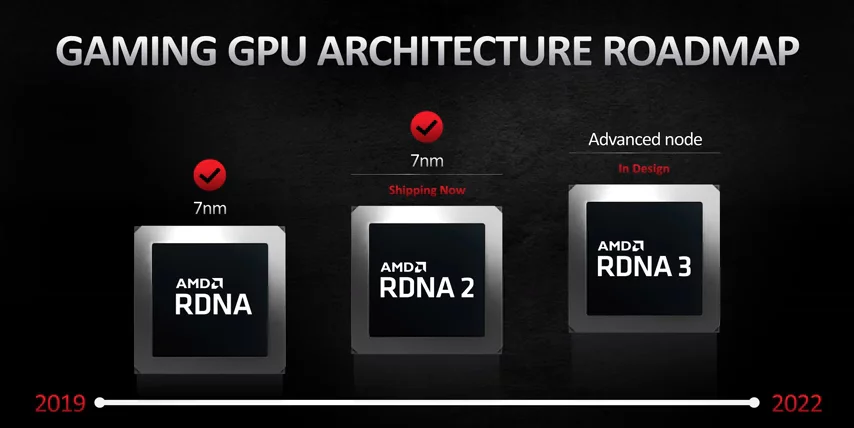
Given that NVIDIA had a performance lead before they moved to their new eight-nanometer node with Ampere, and considering the performance they gained by doing so, AMD staying on their old process might not sound like it bodes well for the new cards. But they claim that, compared to the Radeon 5000 series, they've pulled off up to 200% better performance and 50% better performance per watt, which mostly just means that the power draw is the same. 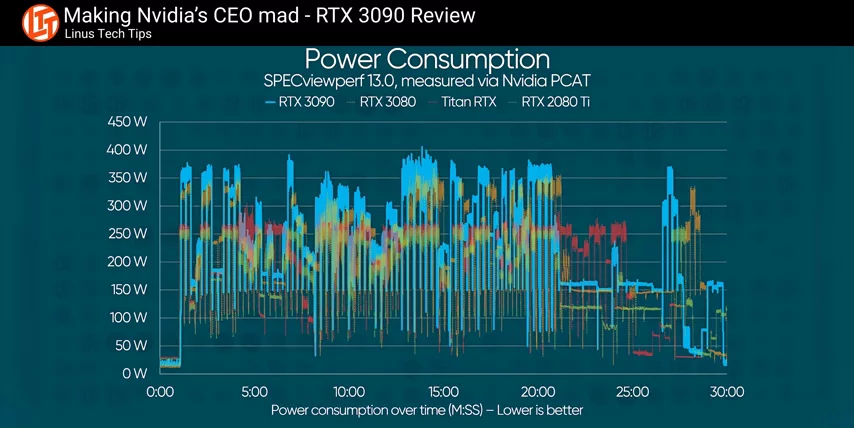 But still, considering that the higher-end RTX 3000 series from NVIDIA is chugging down power like it's trying to drain a lake, not too shabby.
But still, considering that the higher-end RTX 3000 series from NVIDIA is chugging down power like it's trying to drain a lake, not too shabby.
How'd they accomplish all that? Well, unfortunately, AMD didn't go into much depth, but they did say that they tuned their core design for frequency and power efficiency, which is, like, what the hell else would you tune it for? You're not tuning it for crappy clock speeds and crummy power consumption. So that's all marketing speak, but they did provide a couple preliminary details if we drill a touch deeper.
The pipeline has been completely rebalanced with a focus on optimizing data paths. 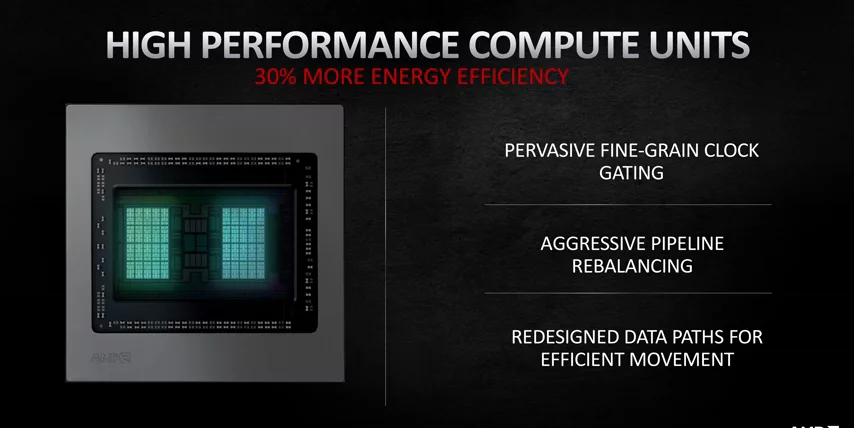 That could mean another update to the way that workgroups are handled in parallel, or it could mean something entirely different. We're gonna have to get our hands on them to know for sure. All we can say for now is that AMD assures us that it's been designed for efficiency first.
That could mean another update to the way that workgroups are handled in parallel, or it could mean something entirely different. We're gonna have to get our hands on them to know for sure. All we can say for now is that AMD assures us that it's been designed for efficiency first.
Efficiency is good, but what other goodies do we have with the new architecture?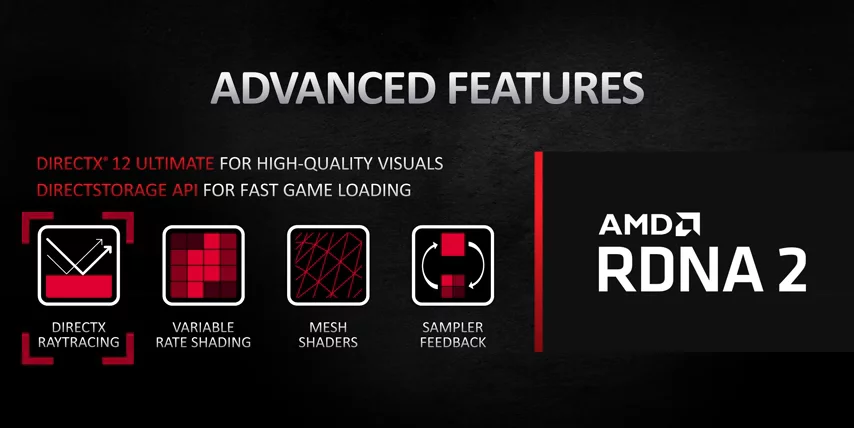 For one, we're getting full ray-tracing support in the form of ray accelerators built into every compute unit, which not only allows the new GPUs to run any standard ray-traced title to date, but also enables new functionality with FidelityFX, AMD's open source image processing toolkit, including a denoiser for ray-traced content and acceleration for the ambient occlusion and screen space reflection features that AMD's already using.
For one, we're getting full ray-tracing support in the form of ray accelerators built into every compute unit, which not only allows the new GPUs to run any standard ray-traced title to date, but also enables new functionality with FidelityFX, AMD's open source image processing toolkit, including a denoiser for ray-traced content and acceleration for the ambient occlusion and screen space reflection features that AMD's already using. 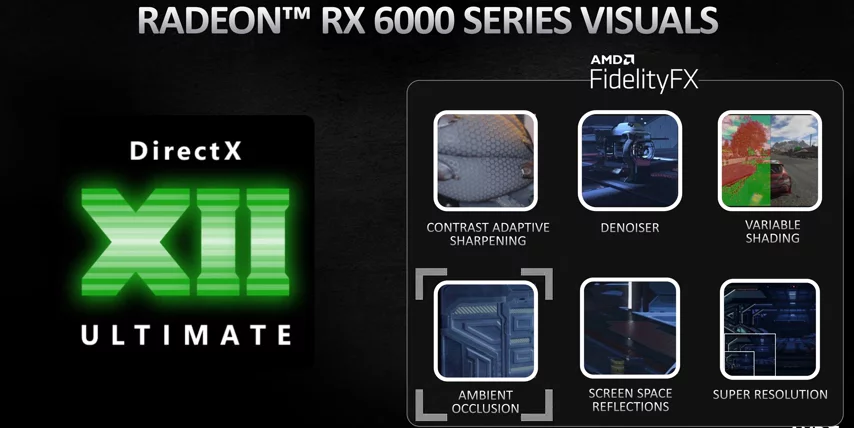
AMD says that their ray accelerators are 10 times faster than ray tracing in software, though we don't really have a baseline for that since AMD never enabled a ray tracing API for RDNA 1. I have a good feeling about it though from looking at GTX cards running ray tracing in software.
Those features tie into AMD's overarching support for DirectX XII Ultimate, which also includes things like variable rate shaders that dynamically reduce complexity for less frequently updated portions of the screen, mesh shaders that combine multiple shading passes at once, and of course DirectStorage support which is baked into both of the new RDNA 2-powered consoles, sort of. The PlayStation implementation is not quite DirectStorage, which is a Microsoft tech.
As a result then, AMD claims that because the consoles will be optimizing for exactly these features, cross-platform PC games will be tuned for them pretty much by default. It's obviously not quite that simple, but my hopes are still pretty high.
AMD also offered us a glimpse at a feature they call Super Resolution, which, for all intents and purposes, sounds like their version of DLSS, except not using quite the same method.
Finally, there's something that AMD is calling Infinity Cache, which I swear is not a cryptocurrency. It does sound like one though, doesn't it? 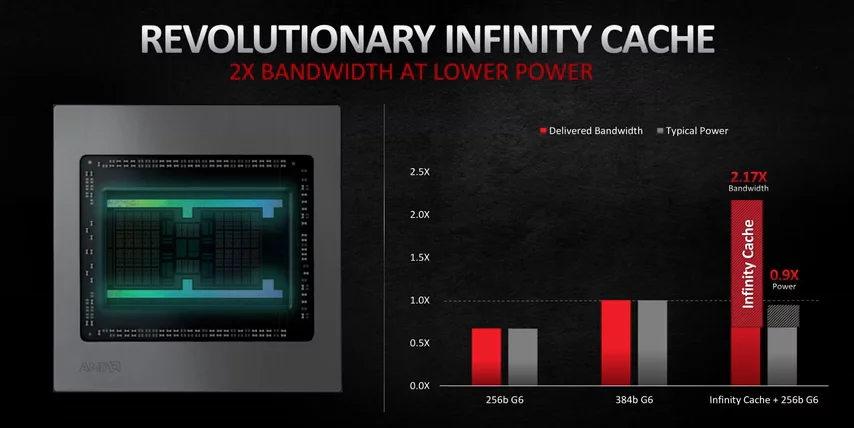 Instead, Infinity Cache consists of 128 megabytes of extremely fast on-die memory that, just like Ryzen's cache, keeps the GPU fed during memory-intensive operations, which AMD specifically says minimizes DRAM bottlenecks.
Instead, Infinity Cache consists of 128 megabytes of extremely fast on-die memory that, just like Ryzen's cache, keeps the GPU fed during memory-intensive operations, which AMD specifically says minimizes DRAM bottlenecks.
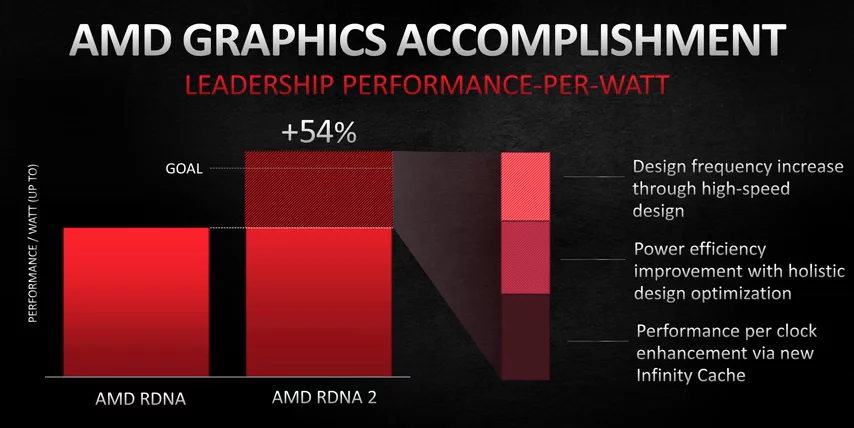 From AMD's slides, it looks like this alone accounts for 40% of RDNA 2's overall performance improvement and in theory it should allow RDNA 2 to maintain performance at high resolutions despite the 256-bit GDDR6 not-X memory that AMD's using on all of its Radeon 6000 GPUs.
From AMD's slides, it looks like this alone accounts for 40% of RDNA 2's overall performance improvement and in theory it should allow RDNA 2 to maintain performance at high resolutions despite the 256-bit GDDR6 not-X memory that AMD's using on all of its Radeon 6000 GPUs.
And which GPUs are there? Well, got a couple for ya: the RX 6800 and 6800XT are the two GPUs that AMD is prepping to try and propel themselves back to enthusiast status, with the RX 6800 completely dominating tomorrow's RTX 3070 in performance, if AMD's slides are to be believed, bearing in mind though that the 3070 is roughly equivalent to an RTX 2080 Ti.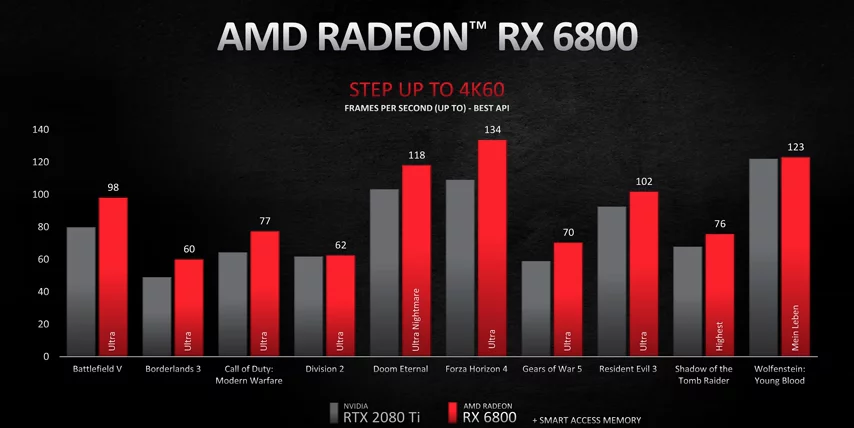 It really is no wonder NVIDIA carpet bombed the news cycle. If these numbers are true, and we will of course confirm them before the simultaneous launch of the 6800 and 6800 XT on November 18th, I am officially telling you, to wait for RX 6800 before buying a 3070. And if you're one of the many waiting on an RTX 3080, the fact that the RX 6800 XT is expected to trade blows with it while drawing slightly less power may be enough to give you pause as well.
It really is no wonder NVIDIA carpet bombed the news cycle. If these numbers are true, and we will of course confirm them before the simultaneous launch of the 6800 and 6800 XT on November 18th, I am officially telling you, to wait for RX 6800 before buying a 3070. And if you're one of the many waiting on an RTX 3080, the fact that the RX 6800 XT is expected to trade blows with it while drawing slightly less power may be enough to give you pause as well.
But wait, what's that the performance slides say? Rage mode? Smart Access Memory? What the heck are these?
Well, Rage mode is basically an easy mode way to bump up the power target and fan curves in a single click, although AMD admit that it's probably only going to net you 1 to 2% better performance. As for Smart Memory Access, well, here's where things get really interesting.
AMD is leveraging their platform control with Ryzen 5000 and 500 series motherboards by allowing those CPUs to directly address the new Radeon 6000 series' memory, all 16 gigs of it. 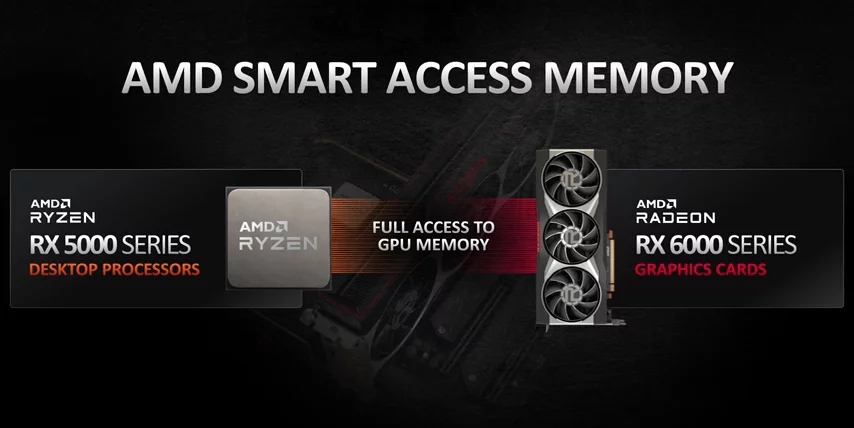 Usually this has to be done in 256-megabyte chunks in the form of the PCI Express base address register, or BAR, which means that Ryzen plus Radeon allows for a level of optimization that simply isn't possible on a traditional system using previous-gen Ryzen or Intel CPUs.
Usually this has to be done in 256-megabyte chunks in the form of the PCI Express base address register, or BAR, which means that Ryzen plus Radeon allows for a level of optimization that simply isn't possible on a traditional system using previous-gen Ryzen or Intel CPUs.
Currently, this is optimized primarily for games, and while not all games will see a benefit, performance uplift according to AMD should be somewhere between 6 and 10% for those that do, just from having a fifth-gen Ryzen CPU.
And one more thing: who could forget the big boy, the RX 6900 XT? 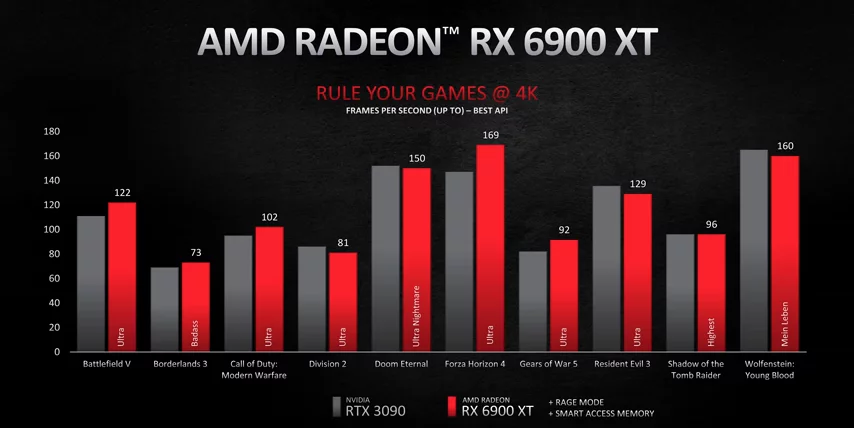 An 80-compute unit Radeon GPU with performance that is allegedly on par with the 350-watt RTX 3090, yet with a total graphics power of 300 watts and a power supply requirement of just 650 watts. That happens to be the same power requirements as the RX 6800 XT and the same core clocks.
An 80-compute unit Radeon GPU with performance that is allegedly on par with the 350-watt RTX 3090, yet with a total graphics power of 300 watts and a power supply requirement of just 650 watts. That happens to be the same power requirements as the RX 6800 XT and the same core clocks. 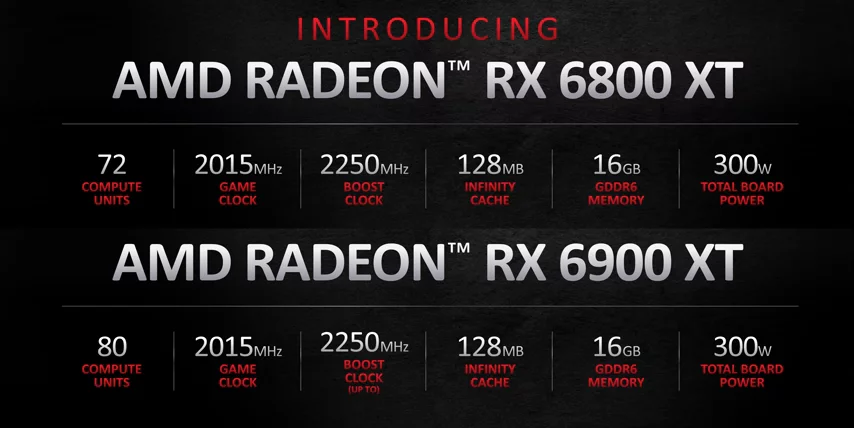 Clearly this is a really, really well-binned piece of silicon, if that is to be believed, and maybe that's why AMD is giving themselves another three weeks to release it. Hopefully they don't have to push it back any further to resolve supply shortages.
Clearly this is a really, really well-binned piece of silicon, if that is to be believed, and maybe that's why AMD is giving themselves another three weeks to release it. Hopefully they don't have to push it back any further to resolve supply shortages.
I guess we won't know any more than this until we have the cards in our hands, and we've seen them on store shelves, which is another three weeks out, but at that time we are going to have a very good idea of how Ryzen 5000 and RTX 3070 are going to perform, so we're going to have plenty of comparison points for our review.
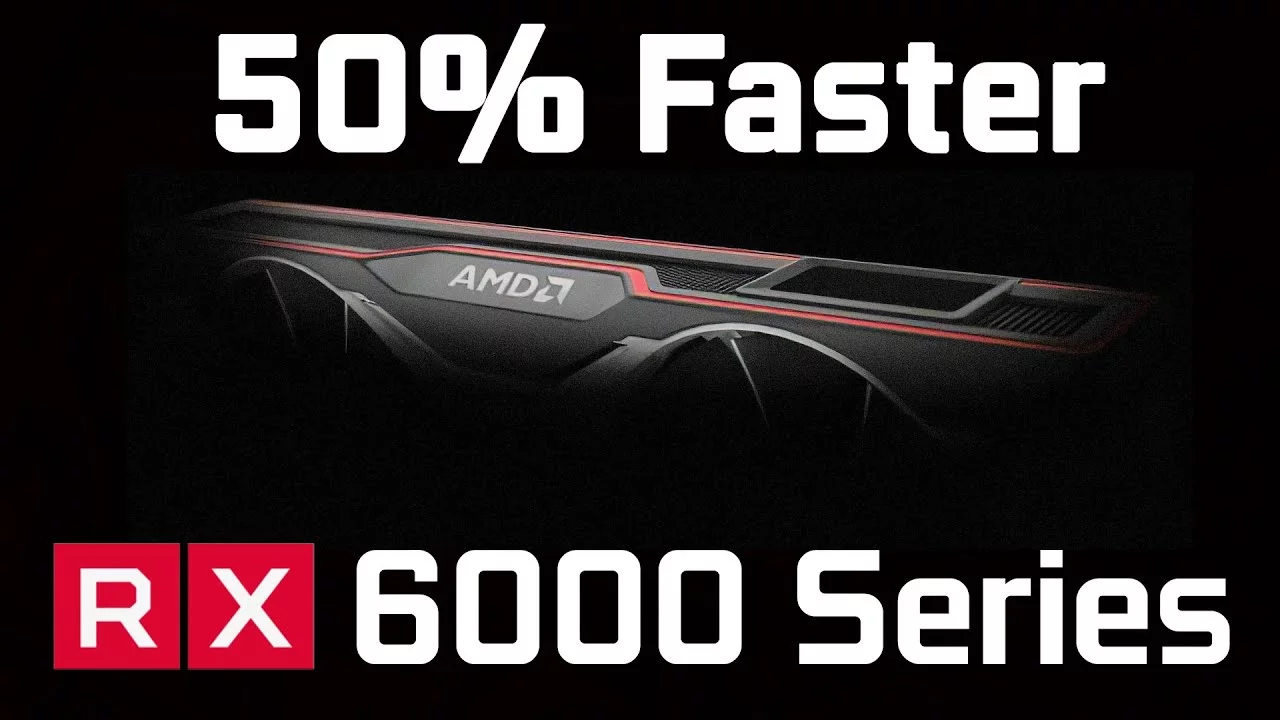

No comments yet